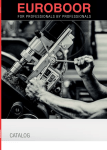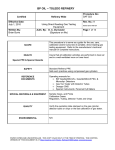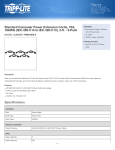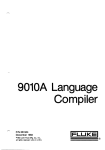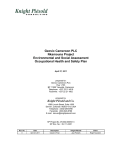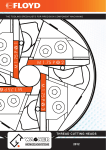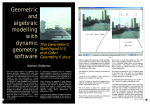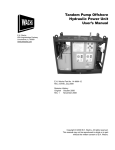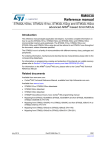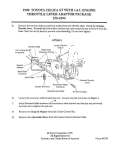Download Upper Bay Technician --- Four Person Team
Transcript
Upper Bay Technician (UBT) --- Four Person Team OJT/ Practice DTOG Proficiency Exam Date: _________________________________ Trainee: _________________________________ Trainer: _________________________________ Service Center: _______________________ Upper Bay Technician --- Four Person Team Preparation Check the activity board, daily plan or position chart Review primary and secondary duties Secondary: Acknowledge customers Secondary: Assist CT Secondary: Performs tidies/cleans as assigned Dressed in the proper uniform to include the recommended Personal Protective Equipment (PPE) At assigned position and ready to serve the customer at scheduled time Station adheres to the requirements outlined in the Guide to Excellence DTOG - Upper Bay Technician - 4-Person Team Action/Behavior Call/Response Rating Review position duties and tasks Discuss with LBT and CT responsibilities for secondary duties 1 1 2 2 P P Clean uniform, shirt tucked in buckle-less belt, personal grooming standards present 1 2 P 1 2 P 1 2 P Clean, organized, properly stocked and all tools are accessible 1 Version: March 16, 2015 Primary Duty and Task 1. Start the Service Action/Behavior Be ready Positioned at the front of the service bay Communicates proper call Follows proper safety procedures using JLI Call and Response System), clear and audible, awaits LBT response Guide vehicle in Clear hand signals, safely positioned from path of vehicle, properly positions vehicle over the service bay DTOG - Upper Bay Technician - 4-Person Team 2 Call/Response Rating Call/Response UBT: “Car coming in, Bay #” LBT: “Thank you, Bay #” 1 2 P 1 2 P 1 2 P Version: March 16, 2015 2. Report on Conditions After the vehicle has come to a complete stop and is properly positioned at the front of the service bay, perform the light inspection Raise the hood Check the oil level Confirm and communicate service Flag transmission dipstick, if applicable Remove the air filter and additional air filtration components as applicable If applicable, remove and/or inspect additional components. Check with your manager for the proper procedures in your service center Determine the correct oil filter application Physically verify new oil filter All tasks completed within 80 seconds Clear audible directions to CT and LBT, accurate report of lights 1 2 P Secure the hood prop, place the fender covers Verify oil level on dipstick, note any unusual conditions, if condition of oil/oil level is extreme notify CSA and customer prior to service, remove oil cap and place in or near hood latch Clear and audible, listen for response from LBT 1 2 P 1 2 P 1 2 P Remove transmission dipstick halfway 1 2 P Clean and remove air filter housing, remove and place air filter and additional components on fender cover, clean inside of housing 1 2 P 1 2 P 1 2 P 1 2 P 1 2 P Use the Electronic Service Manual to identify the correct oil filter Lower Bay Technician sets oil filter at front of bay and UBT verifies it is correct. Accuracy, thoroughness, efficiency and HSSE practices clearly demonstrated Call/Response UBT: “Signature Service, Bay #.” LBT: “Thank you, Bay #.” Call/Response UBT: “___ oil filter, Bay #.” LBT: “___ oil filter, Bay #.” Note: Additional time may be required if Additional ROC items are checked DTOG - Upper Bay Technician - 4-Person Team 3 Version: March 16, 2015 3. Check/Adjust Tires For all trucks, vans, or SUV’s with “P” tires: All four tires; Check tire type, size and color of valve stem caps Most vehicles are equipped with tires that are inflated with compressed air; however some vehicles are equipped with nitrogen filled tires. Nitrogen filled tires can be identified by green or blue valve stem caps. Verify placard information matches information for all four tires Remove valve caps, set/adjust tires to the pressure recommendation from placard, follow safety practices and never exceed the maximum pressure rating indicated on the sidewall, replace valve caps Check vehicle placard for tire type and size If the vehicle is equipped with nitrogen tires and if all information matches placard, and the service center is equipped to inflate nitrogen tires set/adjust tires to proper inflation If the service center is NOT equipped to inflate nitrogen tires 1 2 P 1 2 P 1 2 P Inform CSA and customer. Proceed only after receiving direction from CSA or upon customers authorization to use compressed air If the vehicle is equipped with TPMS: Handle the valve stem carefully to avoid damaging the TPMS sensor Do NOT attempt to remove frozen valve stem caps Do NOT overtighten valve stem caps Do NOT replace missing valve stem caps unless TPMS compatible valve stem caps are available DTOG - Upper Bay Technician - 4-Person Team 4 Version: March 16, 2015 3. Check/Adjust Tires (continued) If the vehicle is equipped with tires inflated with compressed air and if all the information matches the placard set/adjust tires to proper inflation. Check with your manager for the proper sequencing for inflating tires in your service center Remove valve caps, set/adjust tires to the pressure recommendation from placard follow safety practices and never exceed the maximum pressure rating indicated on the sidewall, replace valve caps. If the vehicle is equipped with TPMS: Handle the valve stem carefully to avoid damaging the TPMS sensor Do NOT attempt to remove frozen valve stem caps Do NOT overtighten valve stem caps Do NOT replace missing valve stem caps unless TPMS compatible valve stem caps are available If there is no placard or further verification is needed, check the industry accepted Tire Guide or ESM. If unable to locate information For all other vehicles (passenger vehicles and trucks, vans, or SUV’s with “LT” tires: Check tire type, size and color of valve stem caps Check vehicle placard for tire type and size DTOG - Upper Bay Technician - 4-Person Team Inform CSA or TL immediately, provide tire type and size, TAKE NO FURTHER ACTION, only inflate tires when verification is received from CSA or TL. All four tires Most vehicles are equipped with tires that are inflated with compressed air; however some vehicles are equipped with nitrogen filled tires. Nitrogen filled tires can be identified by green or blue valve stem caps. Verify placard information matches information for all four tires 5 1 2 P 1 2 P 1 2 P Version: March 16, 2015 3. Check/Adjust Tires (continued) If the vehicle is equipped with nitrogen tires and if all information matches placard, and the service center is equipped to inflate nitrogen tires set/adjust tires to proper inflation Remove valve caps, set/adjust tires to the pressure recommendation from placard follow safety practices and never exceed the maximum pressure rating indicated on the sidewall, replace valve cap If the service center is NOT equipped to inflate nitrogen tires Inform CSA and customer. Proceed only after receiving direction from CSA or upon customers authorization to use compressed air 1 2 P If the vehicle is equipped with TPMS: Handle the valve stem carefully to avoid damaging the TPMS sensor Do NOT attempt to remove frozen valve stem caps Do NOT overtighten valve stem caps Do NOT replace missing valve stem caps unless TPMS compatible valve stem caps are available DTOG - Upper Bay Technician - 4-Person Team 6 Version: March 16, 2015 3. Check/Adjust Tires (continued) If the vehicle is equipped with tires inflated with compressed air and if all the information matches the placard set/adjust tires to proper inflation. Check with your manager for the proper sequencing for inflating tires in your service center If there is no placard or further verification is needed, check the industry accepted Tire Guide or ESM. If unable to locate information Completes tires within two (2) minutes DTOG - Upper Bay Technician - 4-Person Team Remove valve caps, set/adjust tires to the pressure recommendation from placard follow safety practices and never exceed the maximum pressure rating indicated on the sidewall, replace valve caps. If the vehicle is equipped with TPMS: Handle the valve stem carefully to avoid damaging the TPMS sensor Do NOT attempt to remove frozen valve stem caps Do NOT overtighten valve stem caps Do NOT replace missing valve stem caps unless TPMS compatible valve stem caps are available Inform CSA or TL immediately, provide tire type and size, TAKE NO FURTHER ACTION, only inflate tires when verification is received from CSA or TL. Accuracy, thoroughness, efficiency and HSSE practices clearly demonstrated 7 1 2 P 1 2 P Version: March 16, 2015 4. Check/Fill Under Hood Fluids Communicates proper call to LBT Starting on the driver’s side using a clockwise pattern Inspect the brake fluid Check the battery fluid and fill if needed Check the power steering fluid and fill if needed Check the washer fluid and fill if needed Follows proper safety procedures using JLI Call and Response System), clear and audible, awaits LBT response 1 2 P 1 2 P 1 2 P Call/Response UBT: “Adding power steering fluid Bay #.”(if applicable) LBT: “Thank you, Bay #.” 1 2 P Call/Response UBT: “Adding washer fluid Bay #.”(if applicable) LBT: “Thank you, Bay #.” 1 2 P Clean reservoir/cap, determine fluid level Note: Because of the potential risk of fluid contamination, Jiffy Lube DOES NOT inspect brake fluid levels on vehicles with non-translucent reservoirs Note any unusual conditions and enter into comments during the “complete checkpoints” duty/task Determine battery type, check condition, proper communication if adding Note any unusual conditions and enter into comments during the “complete checkpoints” duty/task Clean reservoir/cap using a clean shop towel, verify fluid application, proper communication if adding Note any unusual conditions and enter into comments during the “complete checkpoints” duty/task Clean reservoir/cap, using a clean shop towel; proper communication if adding Note any unusual conditions and enter into comments during the “complete checkpoints” duty/task DTOG - Upper Bay Technician - 4-Person Team Call/Response UBT: “Checking under hood fluids Bay #.” LBT: “Thank you, Bay #.” 8 Version: March 16, 2015 4. Check/Fill Under Hood Fluids (continued) Completes under hood duties within sixty (60) seconds Accuracy, thoroughness, HSSE practices clearly demonstrated; for efficiency under hood fluids should always be checked starting on the driver's side and following a clockwise direction under the hood --- the order of fluids may change because of vehicle manufacturer specifications 1 2 P 1 2 P 1 2 P 1 2 P 1 2 P 1 2 P 5. Perform Installations Communicate correct fluid applications to LBT Communicate specific application based on vehicle manufacturer recommendations Respond to Lower Bay requests for fluid application by looking up correct fluid in ESM and communicating it to Lower Bay Call/Response LBT: “Fluid application, rear differential, Bay #.” UBT: “GL-5, rear differential, Bay #.” Gather any new ROC items, bottled oil, etc Install/re-install items Responds to LBT communication Communicates proper call to LBT DTOG - Upper Bay Technician - 4-Person Team Follows service requests, care taken during installation to avoid wires, cables Follows proper safety procedures using JLI Call and Response System), clear and audible Follows proper safety procedures using JLI Call and Response System), clear and audible, awaits LBT response 9 Call/Response LBT: “Ready for oil, Bay #.” UBT: “Thank you, Bay #.” Call/Response UBT: “Adding oil Bay #.” LBT: “Thank you Bay #.” Version: March 16, 2015 5. Perform Installations (continued) Add oil Uses proper viscosity, no oil on engine compartment, replaces oil cap 1 2 P NOTE: For some vehicles, you must reinsert the dipstick completely to prevent oil spills during the pressure check. Request under vehicle status from LBT Clear and audible, listen for response, complete proper communication Call / Response UBT: “Under vehicle status, Bay #.” LBT: “Added ___ pint to rear differential, ___ fittings, no unusual conditions Bay #.” UBT: “Thank you, Bay #.” 1 2 P Call/Response UBT: “Clear to start, Bay #.” LBT: “Clear to start, Bay #.” UBT: “Starting, Bay #.” LBT: “Thank you, Bay #.” 1 2 P 1 2 P 1 2 P 1 2 P 6. Perform the Pressure Check Communicates proper call to LBT Follows proper safety procedures using JLI Call and Response System), clear and audible, awaits LBT response Start the vehicle Both feet in vehicle, foot on brake Check oil pressure Verifies oil pressure, waits a minimum of 10 seconds (minimum of 60 seconds for canister filters ) Performs inspection of interior of vehicle Inspect vacuuming, windows, placement of reminder sticker, note any reset indicators, such as the TPMS indicator DTOG - Upper Bay Technician - 4-Person Team 10 UBT: “Pressure up, Bay #.” LBT: “System sealed, Bay #.” Version: March 16, 2015 7. Check/Fill Transmission / Transaxle Fluid Communicates proper call to LBT Follows proper safety procedures using JLI Call and Response System), clear and audible, awaits LBT response Check transmission/transaxle fluid Engine running unless specified by vehicle manufacturer, in park or neutral as specified by the manufacturer, check dipstick, proper communication if adding Some service centers perform this check during the ROC. If this is the procedure in your service center, the proper procedures to include all safety requirements must be followed. Check with your manager for the proper procedure in your service center. Reset indicator lights 1 2 P 1 2 P Turn engine off and reset indicator lights as applicable. 1 2 P Include status of all items checked and tire pressure for front and rear tires, accurate data entry 1 2 P 1 2 P Call/Response UBT: “Checking transmission fluid, Bay # LBT: “ Thank you, Bay # Call/Response UBT: “Adding transmission fluid, Bay #.”(if applicable) LBT: “Thank you Bay #.” Check with your manager for the proper procedure in your service center. 8. Complete vehicle status and checkpoints Complete checkpoints screen Enter in comments section any unusual conditions; such as cracked reservoir. Enter in comments section tire pressure request from customer; for example, 37 PSI per customer request Complete and forward the invoice DTOG - Upper Bay Technician - 4-Person Team Accurate data entry, exact oil quantity 11 Version: March 16, 2015 9. Request Quality Inspection Check oil level and add if needed Request quality inspection Observe/listen as lower bay performs quality inspection Perform upper bay quality inspection Communicates proper call DTOG - Upper Bay Technician - 4-Person Team Remove dipstick, proper communication if adding, secure dipstick. Call/Response UBT: “Adding additional oil, Bay #.”(if applicable) LBT: “Thank you Bay #.” Follows proper safety procedures using JLI Call/Response Call and Response System, clear and UBT: “Quality inspection, audible Bay #.” Crouched position at front of service bay, Call/Response show dipstick to lower bay, observe wrench LBT: “Oil level verified. on plugs, hand on filter, count of fittings, Wrench on differential visually inspect gasket on old filter, ensure plug, tight. bay covering/net is firmly secured at the Added ___ pints fluid type front of the service bay. to the rear differential. Hand on ____ filter, tight. Wrench on oil drain plug, tight. ____ fittings. No unusual conditions. Gasket on old filter. Quality inspection complete, Bay #.” UBT: “Thank you, Bay #.” Hand check all caps, dipsticks, removes fenders covers, lowers hood prop, secures hood prop, lowers hood, verifies latch is secure Follows proper safety procedures using JLI Call/Response Call and Response System), clear and UBT: “All caps tight, audible dipsticks secure, hood coming down Bay #.” LBT: “Thank you Bay #.” 12 1 2 P 1 2 P 1 2 P 1 2 P 1 2 P Version: March 16, 2015 10. Complete the Service Guide the vehicle out of the bay Respond to next customer DTOG - Upper Bay Technician - 4-Person Team Clear hand signals, safely positioned from path of vehicle Assist other team members or as directed, maintain work area, perform additional tidies/cleans 13 1 2 P 1 2 P 1 2 P Version: March 16, 2015













